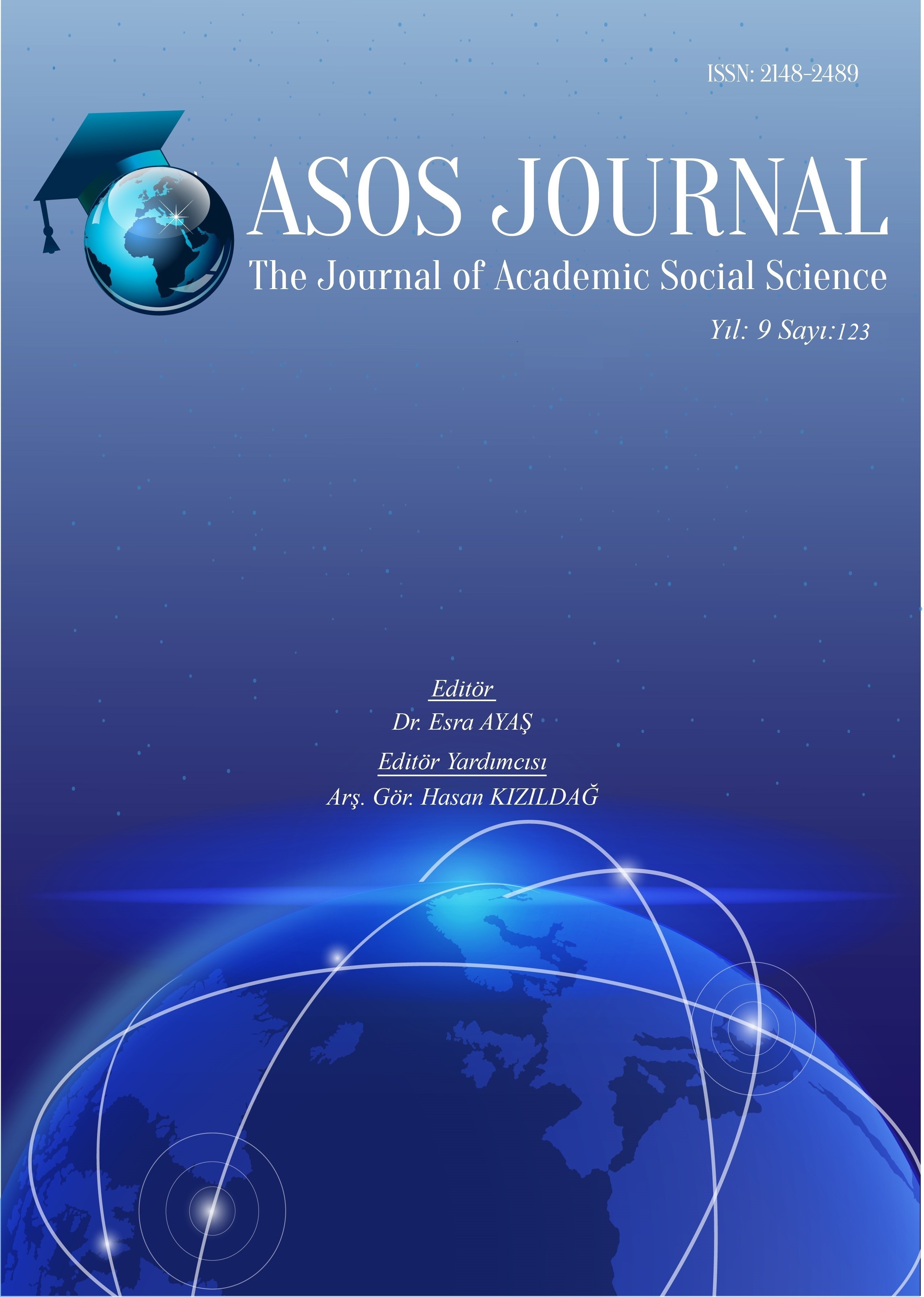İNGİLİZCENİN YABANCI DİL OLARAK ÖĞRETİLDİĞİ SINIFLARDA İŞBİRLİĞİNE DAYALI ÖNERİLEN YAZMA ETKİNLİKLERİ
Author :
Abstract
Yapılan bu araştırmada, işbirliğine dayalı, lise öğrencileri için tasarlanmış yazma etkinlikleri önerilip, bu etkinliklerin 9. sınıf öğrencilerinin İngilizce yazma becerileri üzerindeki etkisini incelenmiştir. 2018-2019 akademik yılı içinde yürütülen bu araştırma için 9. sınıfta okuyan 28 öğrenci seçilmiştir. Araştırmaya katılan öğrencilerin ön-test ve son-test uygulamaları arasındaki yazma etkinliklerine olan ilgi ve tutumlarını test etmek amacıyla, araştırmacı tarafından hazırlanan “Öğrencilerin Yazma Etkinliklerine Olan Yaklaşımlarını Belirleme Değerlendirme Ölçeği” kullanılmıştır. Araştırmada ön-test, son-test model yöntemi kullanılmış; verilerin analizi IBM SPSS İstatistik 21 paket programı kullanılarak yapılmıştır. Araştırmada kontrol gurubu yer almamaktadır. Sekiz hafta süren öğretim etkinliği boyunca, sekiz birbirinden farklı yazma aktivitesi deney gurubu olan 9/A sınıfında uygulanmıştır. Bu aktivitelerin öncesinde ve sonrasında araştırmacının kendisi tarafından geliştirilen ve uygulanan Değerlendirme Ölçeği sonuçları incelendiğinde elde edilen bulguya göre işbirliğine dayalı olarak geliştirilmiş yazma becerisine yönelik öğretim etkinliklerinin lise öğrencililerinin yazma etkinliklerine olan istek ve ilgilerini artırdığı görülmüş ve dolayısıyla yazma becerilerinin gelişimi üzerinde etkisi olacağı öngörülmüştür.
Keywords
Abstract
In this study we suggest writing activities based on Cooperative Learning in EFL classes for high School students and examine the effect of these activities on the interest in writing skill of 9th grade students. The study has been conducted with 28 students studying at a high school at 9th grade during the academic year of 2018-2019. To test the effect of the suggested activities on their interests in writing, “The Evaluation Scale of the Students‟ Approach to Writing Activities” which has been designed by the researcher is used as pre-test and post-test. The research does not involve a control group: in order to analyse the findings IBM SPSS Statistics 21 software programme has been used. During eight weeks of teaching process, eight different writing activities are studied in experimental group which is 9/A class. According to the analysis of the results of the Evaluation Scale conducted before and after the activities studied, it was seen that the suggested writing activities based on Cooperative Language Learning increased the high school students‟ desire and interest in writing activities and hence the activities are predicted to have an effect on the development of their writing skills.
Keywords
- Arumugam, N., & Abdullah, F. (2013). Cooperative language learning in the tertiary ESL writing classroom: Student views from diverse settings. In F. K. Abdullah, ZM & M. Yult (Eds.), Recent Research Topics in Malaysian English Language Studies (pp. 174188).
- Azizinezhad, M., Hashemi, M., & Darvishi, S. (2013). Application of cooperative learning in EFL classes to enhance the students’ language learning. Procedia-Social and Behavioral Sciences, 93, 138-141.
- Boughey, C. (1997). Learning to write by writing to learn: a group-work approach. ELT journal, 51(2), 126-134.
- Brown, H. D. (2001). Teaching by principles: An interactive approach to language pedagogy (2 ed. Vol. 1). New York: Prentice Hall Regents Englewood Cliffs, NJ.
- Celce-Murcia, M. (2001). Teaching English as a second or foreign language (3 ed.). Boston, Massachusetts: Heinle & Heinle Publishers.
- Er, G., & Azap, S. (2013). The effect of cooperative learning activities based on multiple intelligences theory on vocabulary learning in EFL classes. Journal of Kazım Karabekir Education Faculty, 27, 77-98.
- Harmer, J. (2001). The practice of English language teaching (3 ed.). England: Pearson Education ESL.
- Harmer, J. (2004). How to teaching writing (2 ed.). England: Pearson Education ESL.
- Higgins, L., Flower, L., & Petraglia, J. (1992). Planning text together: The role of critical reflection in student collaboration. Written communication, 9(1), 48-84.
- Horwitz, E. K. (2008). Becoming a Language Teacher: A Practical Guide to Second Language Learning and Teaching Boston: Pearson Education.
- Kagan, S. (1994). Cooperative learning. California: Kagan Publishing.
- Kagan, S. (2009). Kagan’s cooperative learning. San Clemente: Kagan Publishing.
- Kessler, C. (1992). Cooperative Language Learning: A Teacher's Resource Book. New York: Englewood Cliffs, N.J. : Prentice Hall Regents.
- Khatri, D. K. (2014). Effectiveness of Guided Writing in Teaching Composition. Journal of NELTA Surkhet, 4, 18-25.
- Leeser, M. J. (2004). Learner proficiency and focus on form during collaborative dialogue. Language Teaching Research, 8(1), 55-81.
- McDonell, W. (1992). The role of the teacher in the cooperative learning classroom. In C. Kessler (Ed.), Cooperative Language Learning: A Teacher's Resource Book (pp. 163173). New York: Englewood Cliffs, N.J. : Prentice Hall Regents.
- McGroarty, M. (1989). The benefits of cooperative learning arrangements in second language instruction. NABE journal, 13(2), 127-143.
- Ngubane, N. I. (2015). The effectiveness of cooperative learning in an English first additional language classroom.
- Nunan, D. (1999). Second Language Teaching & Learning. Boston, USA: Heinle & Heinle Publishers.
- Olsen, R. E. W. B., & Kagan, S. (1992). About Cooperative Learning. In C. Kessler (Ed.), Cooperative Language Learning: A Teacher's Resource Book (pp. 1-30). New York: Prentice Hall.
- Richards, J. C., & Rodgers, T. S. (2001). Approaches and methods in language teaching (Cambridge language teaching library) (2 ed.). England: Cambridge University Press.
- Shen, Y. (2010). EFL Learners‟ Synonymous Errors: A Case Study of Glad and Happy. Journal of Language Teaching and Research, 1(1), 1-7.
- Shih, M. (1986). Content‐based approaches to teaching academic writing. Tesol Quarterly, 20(4), 617-648.
- Stepanovienė, A. (2013). Cooperative learning in the context of foreign language teaching and learning. VISUOMENĖS SAUGUMAS IR VIEŠOJI VARKA PUBLIC SECURITY AND PUBLIC ORDER, 9, 246-254.
- Storch, N. (2005). Collaborative writing: Product, process, and students’ reflections. Journal of second language writing, 14(3), 153-173.
- Storch, N. (2011). Collaborative writing in L2 contexts: Processes, outcomes, and future directions. Annual Review of Applied Linguistics, 31, 275-288.
- Yang, L. (2014). Examining the mediational means in collaborative writing: Case studies of undergraduate ESL students in business courses. Journal of second language writing, 23, 74-89.
- Zarrabi, F. (2016). A study on cooperative language learning: the impact of CLL approach on English language proficiency of EFL learners. European Journal of Education Studies.
